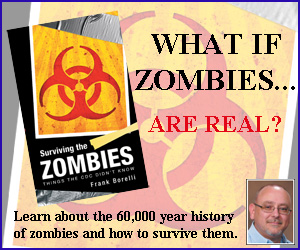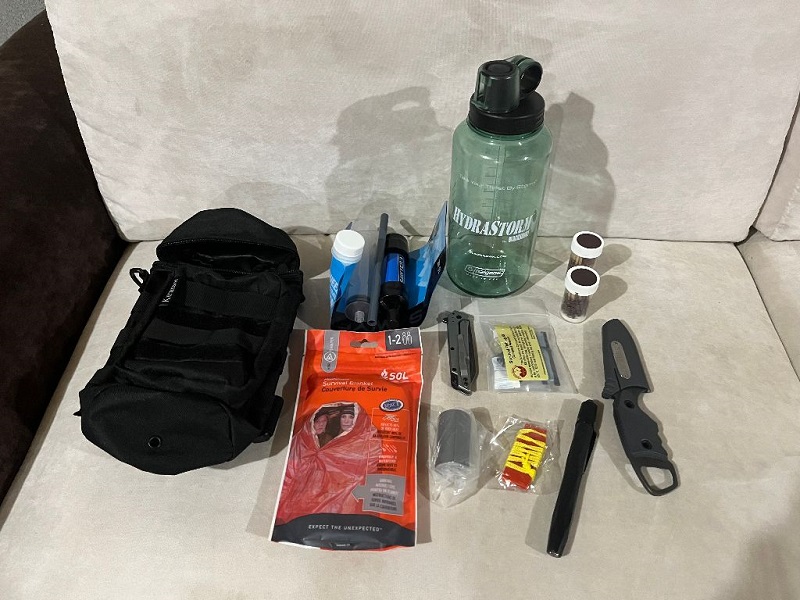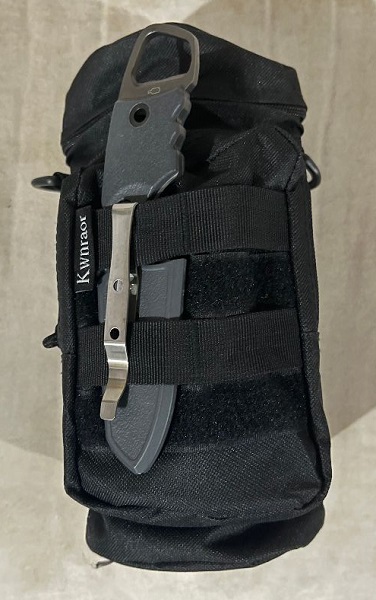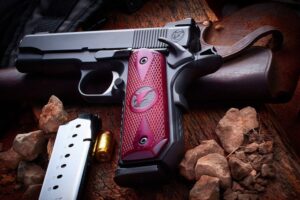I’d love to take full credit for this idea, but I can’t. I came across this concept in a Facebook advertisement of all things. That said, I took at look at what they had included in their “Water Bottle Survival Kit,” and saw some redundancies, and I also thought of some things I thought they should have included but didn’t. So, true to form, I pulled out my one-liter Nalgene water bottle from Hydrastorm (by BLACKHAWK) and started researching. I wanted a complete basic emergency survival kit that would fit in that bottle and a way to carry the bottle conveniently.
Keep in mind as you read this that I’ve long believed my Uncle Don’s “Rule of Life:” Never leave your house without a knife, a gun and a lighter. That way you can catch food, clean food and cook food. So any knives or fire starting devices listed for our survival kit are redundant to those you should have in your pockets.
As I’ve written in the past, there are very basic survival necessities you need to provide for in any survival kit. They are:
- Shelter
- Warmth
- Hydration
- Food
 Shelter and warmth can often be combined but it’s to your advantage if you can have something to provide for shelter – to protect you from rain, snow, sun, etc. – and something to provide for warmth – specifically to retain body heat if in a cold environment. Warmth also means having the means to start a fire and that crosses over (potentially) into the ability to purify water and cook food. Food can take many forms, some of which can be carried in and others that can be hunted/gathered while in the field.
Shelter and warmth can often be combined but it’s to your advantage if you can have something to provide for shelter – to protect you from rain, snow, sun, etc. – and something to provide for warmth – specifically to retain body heat if in a cold environment. Warmth also means having the means to start a fire and that crosses over (potentially) into the ability to purify water and cook food. Food can take many forms, some of which can be carried in and others that can be hunted/gathered while in the field.
Shelter:
For years I carried a military surplus poncho and a few lengths of paracord as my survival shelter. What I realized over time was that there are plenty of other options that take up less space and provide an equal amount of potential coverage. A heavy duty “survival blanket” (different from an “emergency space blanket”) can be used as a floor mat, multiple types of shelter and/or a regular blanket. If you combine this with the previously mentioned lengths of paracord, you can set up several different types of shelter depending on your needs.
Warmth:
 The “emergency space blanket,” a thin mylar blanket that reflects 90% of body heat back, is an awesome tool to prevent hypothermia and it has evolved quite a bit in the past couple decades. Not only can you get this super thin material as a blanket, just big enough to cover one person, but you can get it as a bivvy (think sleeping bag) big enough for one person or slightly larger to fit two people. Sharing body heat is always a good idea where hypothermia is a danger, but extra space in an over-large bivvy can mean air pockets susceptible to the cold.
The “emergency space blanket,” a thin mylar blanket that reflects 90% of body heat back, is an awesome tool to prevent hypothermia and it has evolved quite a bit in the past couple decades. Not only can you get this super thin material as a blanket, just big enough to cover one person, but you can get it as a bivvy (think sleeping bag) big enough for one person or slightly larger to fit two people. Sharing body heat is always a good idea where hypothermia is a danger, but extra space in an over-large bivvy can mean air pockets susceptible to the cold.
Staying warm also means the ability to build a fire and that means having fire starting materials. While there are many creative ways to start a fire, the most basic is matches and some kind of tinder material. Yes, a flint and steel can be used but experienced people will tell you that starting a fire with flint and steel, producing sparks to ignite whatever your tinder material is, can be more frustrating and time consuming that simply lighting a match. Offset that with the challenge of keeping all matches dry and usable in austere conditions and make your choices. There are plenty of compact and inexpensive ignition tools on the commercial market. Choose wisely and include it in your kit.
Hydration:
This isn’t just the ability to carry water but also the ability to purify water from questionable sources. Dysentery can kill you through dehydration and removing the nutritional potential of anything you eat. In the past, the best answer was to boil your water or use water purification tablets (that REALLY don’t make the water taste good). In today’s world there are tools like survival straws and compact water filter systems. For redundancy on this survival imperative (potable drinking water), it’s a good idea to have both a filtration system and water purification tablets. Thankfully, neither of these items takes up much room.
Food:
 While you can go several days without food, your body does need calories both to live and to perform. Walking any significant distance can burn plenty of calories and replenishing them for the next day’s walk is good. In most survival kits you can easily fit one to three food bars. What kind? That’s up to you. Some people prefer protein bars. Others prefer bars high in carbohydrates with some fat content as well. The thing to avoid is bars that are simply high in sugar as your body will process and burn that sugar relatively quickly and then your system will “crash” and you’ll feel exhausted.
While you can go several days without food, your body does need calories both to live and to perform. Walking any significant distance can burn plenty of calories and replenishing them for the next day’s walk is good. In most survival kits you can easily fit one to three food bars. What kind? That’s up to you. Some people prefer protein bars. Others prefer bars high in carbohydrates with some fat content as well. The thing to avoid is bars that are simply high in sugar as your body will process and burn that sugar relatively quickly and then your system will “crash” and you’ll feel exhausted.
Obviously you can also gather food – if you’re knowledgeable enough to know what you can or can’t safely eat and how to prepare it – or you can hunt/fish for food. Rabbit, squirrel, birds and fish are an often available and easily harvested source of food. All of it needs to be cooked and having the ability to prepare that aforementioned fire becomes necessary. To hunt or fish you need either the ability and skill to build snares, or the ability to trap, or the ability to fish. Small fishing kits are available in abundance and you can create your own with a quick trip to any sports section in a department store. Line, hooks, sinkers and small bobbers are all available and small enough to put into a single kit not much bigger than a box of matches.
After you’ve caught your prey or your fish, you need to be able to clean it and prep it for cooking. Therefore, a knife is your most basic and imperative tool. It doesn’t have to be big. Even a two-inch blade can do what is necessary, and some of the most popular “survival” knives available today have blades that measure three to five inches. A folding knife is perfectly acceptable and any knife in your survival kit should be redundant to the one you have on your person.
The complete kit:
Online I sought and found a black nylon 1-liter water bottle carrying pouch. It was made to be carried on a belt or mounted via MOLLE panels to a vest, thigh platform, pack, etc. Most folks don’t realize it but the typical 1-liter water bottle has common dimensions and the mouth of the bottle is about two inches across. So whatever your survival materials are going to be, they have to fold or otherwise fit through that 2” opening. The bottle is also about eight inches tall but the shoulder is about six inches from the bottom. What you have is an internal space roughly 6” tall by 3.5” across.

For my purposes, here is the list of items I put into my water bottle and which needs they address. I also include several tools that can make survival a bit easier – and perhaps not as long of a challenge.
Adventure Medical Kits Survive Outdoors Longer one or two person Survival Blanket. I pack this for use as shelter recognizing that it can be used as a blanket should conditions demand. This blanket weighs just over three ounces and measures just shy of five feet wide by just over eight feet long. (SHELTER / WARMTH)
For the ability to start fire I have two containers of Storm Matches from Coghlan’s. Each container has 25 “windproof and waterproof” matches along with a small supply of tinder material. The containers are sealed like a prescription pill bottle with striking surface on both the top and bottom. (WARMTH / FOOD)
For hydration, the water bottle itself serves as a container to hold water and for filtration I purchased a Sawyer Mini Filtration system for less than $22 on Amazon. It came with a straw and other supplies. The squeeze bag used for gathering dirty water to push through the filter into a clean drinking container (the water bottle) unfortunately doesn’t fit into the bottle itself; I couldn’t get it through the mouth of the bottle. That said, I easily carry it in the nylon pouch around the bottle or in an outside pouch pocket. (HYDRATION)

For less than $14, I also picked up a compact survival fishing kit from Amazon. The Adventurer Compact Survival Fishing kit contained all of the necessary supplies for fishing and the line could also be used for creating a snare if need be (I had plenty of paracord for that as well though). (FOOD)
As additional tools to help make survival perhaps a tad bit easier, I also have a small roll of duct tape (multiple uses), a signal whistle and a penlight (ASP Raven). The penlight has an LED lamp and runs on two very common AAA batteries. I use Duracell because, in my experience, they have the best in-light shelf life and I only revamp/maintain my kit once each year. I don’t need the batteries corroding inside the light. Finally, inside the bottle I have a Kershaw folding knife – the Misdirect with a 2.9” blade. On the outside of the nylon pouch, pushed into the MOLLE webbing, I also have a Gerber fixed blade with a mixed 3” edge. While that particular knife is no longer made, any decent quality fixed blade knife that can be attached to your kit is suitable.
Keep in mind that everything listed above is augmented by the butane lighter that’s always in my pocket when I leave my house and the Zero Tolerance folding knife that I always have as well. Often I have another knife in a pocket (specifically for cutting cigars) and, because I legally can, I have a handgun as well.


